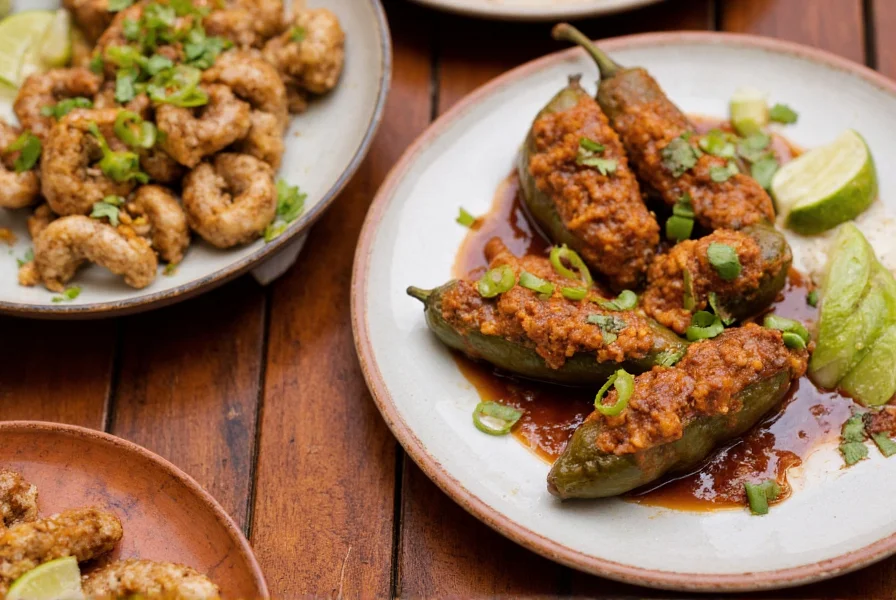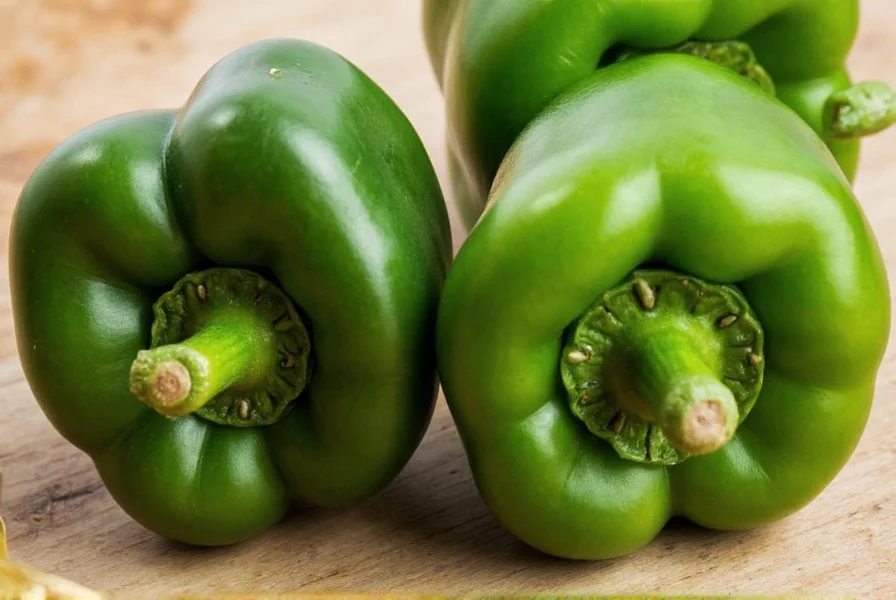Pasilla and poblano peppers are distinct chili varieties often confused due to regional naming differences. Fresh poblano peppers are large, heart-shaped, and dark green, while fresh pasilla peppers (chilacas) are long, thin, and wrinkled. When dried, poblanos become ancho peppers, and chilacas become pasilla peppers. Pasilla peppers (dried chilacas) deliver moderate heat (1,000-2,500 SHU) with raisin-like sweetness, whereas fresh poblanos offer mild heat (1,000-2,000 SHU) with earthy, vegetal notes. Understanding these differences ensures proper usage in Mexican cuisine.
Many home cooks struggle to distinguish between pasilla and poblano peppers, leading to recipe mishaps and flavor imbalances. This confusion stems from inconsistent naming conventions across regions and the transformation these peppers undergo when dried. Let's clarify these two essential ingredients in Mexican cooking with precise, practical information you can trust.
Physical Characteristics: Fresh vs Dried Forms
Understanding the physical differences between these peppers is crucial for proper identification at the market. What many Americans call "pasilla" is actually the dried form of the chilaca pepper, not the poblano. This naming discrepancy causes significant confusion.
| Pepper Type | Fresh Form | Dried Form | Shape & Size | Color |
|---|---|---|---|---|
| Poblano | Large, heart-shaped | Ancho | 3-6 inches long, 2-3 inches wide | Dark green (fresh), deep reddish-brown (dried) |
| Pasilla (Chilaca) | Long, thin, wrinkled | Pasilla | 6-8 inches long, 1-1.5 inches wide | Dark green to blackish (fresh), purplish-brown (dried) |
When shopping, remember that what's labeled "pasilla" in American markets typically refers to the dried chilaca, not a dried poblano. The dried form of the poblano is correctly called ancho. This distinction matters because their flavor profiles differ significantly.

Flavor Profiles and Heat Levels
Heat measurement using the Scoville scale reveals important differences between these peppers:
- Pasilla (dried chilaca): 1,000-2,500 Scoville Heat Units (SHU) with complex flavor notes of dried fruit, licorice, and tobacco
- Poblano (fresh): 1,000-2,000 SHU with mild, earthy, slightly vegetal flavor
- Ancho (dried poblano): 1,000-2,000 SHU with sweet, raisin-like, and smoky notes
While both fall in the mild-to-medium heat range, pasilla peppers generally offer more complex flavor with subtle sweetness, making them ideal for mole sauces. Poblanos provide a cleaner, greener pepper flavor better suited for stuffing or roasting.
Culinary Applications
Understanding proper usage prevents recipe failures. These peppers serve different purposes in Mexican cuisine:
When to Use Pasilla Peppers
Reach for pasilla peppers when you need:
- Authentic mole negro recipes (they're essential for the characteristic dark color and complex flavor)
- Slow-cooked stews requiring deep, smoky-sweet notes
- Sauces where you want subtle fruitiness without overwhelming heat
- Traditional Oaxacan cooking
When to Use Poblano Peppers
Choose fresh poblanos for:
- Chiles rellenos (their thick walls hold up well to stuffing and frying)
- Rajas con crema (sliced roasted poblanos with cream)
- Fresh salsas where you want mild heat with vegetal notes
- As a milder alternative to bell peppers with more flavor complexity

Substitution Guidance
Running out of one pepper doesn't mean abandoning your recipe. Consider these substitutions:
Substituting for Pasilla Peppers
- Best substitute: Ancho + mulato peppers (mix 2 parts ancho to 1 part mulato)
- Acceptable substitute: Guajillo peppers for similar heat with brighter fruit notes
- Avoid: Using fresh poblanos as a direct substitute—they lack the dried complexity
Substituting for Poblano Peppers
- Best substitute: Anaheim peppers (similar mild heat with slightly different flavor)
- Acceptable substitute: Cubanelle peppers for stuffing applications
- Alternative: Bell peppers with a pinch of cayenne for minimal heat
Common Misconceptions Clarified
Several persistent myths cause confusion in home kitchens:
- Misconception: "Pasilla is just the dried form of poblano"
Reality: In Mexico, dried poblanos are called ancho, while pasilla refers to dried chilacas. In the US, "pasilla" incorrectly refers to dried chilacas. - Misconception: "All dark brown dried peppers are pasillas"
Reality: Many dried peppers appear similar. True pasillas (dried chilacas) have distinctive wrinkles and a raisin-like aroma. - Misconception: "Pasilla and poblano can be used interchangeably"
Reality: Their flavor profiles differ significantly. Substituting one for the other alters the dish's character.
Storage and Preparation Tips
Maximize freshness and flavor with these professional techniques:
- Fresh poblanos: Store in the crisper drawer for up to 2 weeks. For longer storage, roast, peel, and freeze in airtight containers (up to 6 months).
- Dried pasillas: Keep in an airtight container away from light and heat. They maintain peak flavor for 6-12 months (test older peppers—they lose potency over time).
- Rehydrating dried peppers: Cover with boiling water and soak for 15-20 minutes until pliable. Reserve the soaking liquid for added flavor in sauces.
- Roasting fresh poblanos: Char over open flame or under broiler, then steam in a covered bowl before peeling for maximum flavor development.
Conclusion: Making the Right Choice for Your Dish
Selecting between pasilla and poblano peppers depends on your specific culinary goal. For authentic Mexican mole sauces requiring deep, complex flavors, seek out genuine pasilla peppers (dried chilacas). When preparing stuffed peppers or fresh salsas that benefit from mild heat and vegetal notes, fresh poblanos deliver the ideal profile. Remember that dried poblanos are correctly called ancho peppers, not pasillas—a crucial distinction for recipe accuracy. By understanding these differences between pasilla vs poblano peppers, you'll elevate your Mexican cooking with authentic flavors and avoid common substitution mistakes that compromise traditional dishes.
Frequently Asked Questions
Can I substitute fresh poblano for dried pasilla in mole?
No, fresh poblanos cannot substitute for dried pasilla peppers in mole. Dried pasillas (chilacas) provide essential raisin-like sweetness and complexity that fresh poblanos lack. For authentic mole, use dried pasilla peppers or substitute with a blend of ancho and mulato peppers.
Why do some recipes call for pasilla when they mean poblano?
This confusion stems from regional naming differences. In Mexico, "pasilla" sometimes refers to dried poblanos, but in the US, "pasilla" correctly refers to dried chilacas. Many American cookbooks and websites perpetuate this misnomer, causing recipe inconsistencies.
How can I tell if I have genuine pasilla peppers?
Authentic pasilla peppers (dried chilacas) are long, thin, deeply wrinkled, and dark purplish-brown. They should have a distinctive raisin-like aroma with notes of tobacco. If your "pasilla" is wide and heart-shaped, it's likely an ancho (dried poblano) mislabeled as pasilla.
Are pasilla peppers hotter than poblanos?
Generally, pasilla peppers (1,000-2,500 SHU) can be slightly hotter than fresh poblanos (1,000-2,000 SHU), but heat varies by growing conditions. The more significant difference is flavor complexity—pasillas offer deeper, fruitier notes while poblanos provide cleaner, greener pepper flavor.
What's the best way to use leftover dried pasilla peppers?
Grind dried pasilla peppers into powder for instant flavor enhancement. Store in an airtight container for up to 6 months. Use the powder to season rubs, soups, or even chocolate dishes for authentic Mexican mole flavor without rehydrating whole peppers.











 浙公网安备
33010002000092号
浙公网安备
33010002000092号 浙B2-20120091-4
浙B2-20120091-4